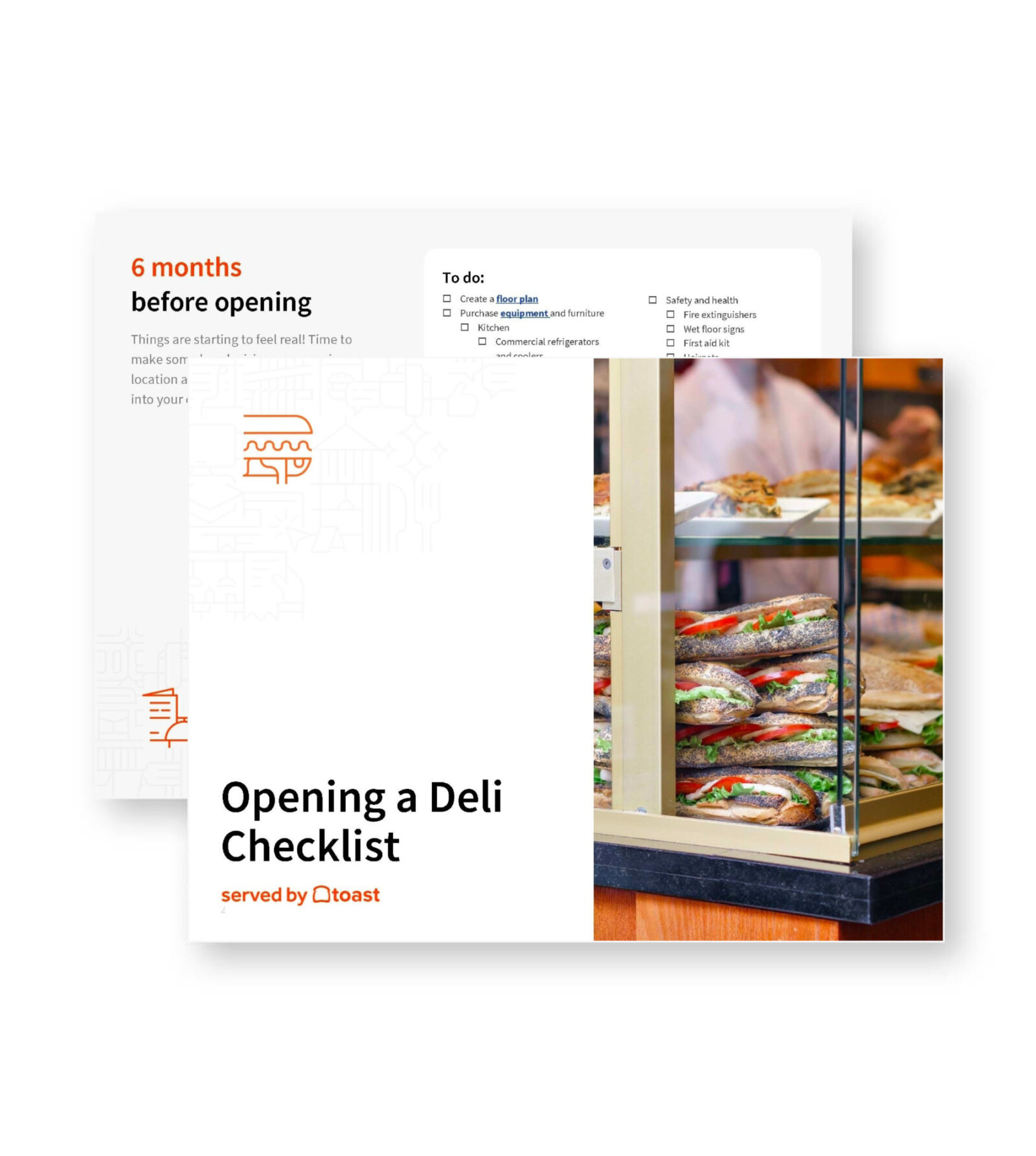
How to Open a Deli: Starting a Deli Business Steps
If you want to open a food business that’s part prepared dishes, part grocery store, with the occasional sandwich and maybe some coffee, this is the roadmap for you.

Katherine BoyarskyAuthor


Opening a Deli Checklist
So many things go into opening a deli. With this free PDF checklist, you'll set your new business up for success.
Get free downloadWhat Do You Need to Start a Deli Business? (Checklist)
New York City isn’t the only part of the country that loves its delis. A delis, or delicatessen, is usually a counter service restaurant-slash-grocery store that sells deli meats like smoked meat, salami, and sausages, as well as cheeses — and if you’re lucky, sandwiches containing any of the above.
Their origins in the US stem from European Jewish immigration from Germany and other parts of Eastern Europe during the 18th and 19th century. By the early 20th century, they were ubiquitous in some parts of the country, cemented as a beloved type of local business where you could grab a sandwich, some high-quality (often housemade or imported) products, along with a pack of gum, a cup of coffee, and some grocery staples.
Today, across the country, there are delis of all kinds, showcasing the food of a wide range of cultures — the main common denominator is that delicious meat products are usually at the heart of the business.
If you’ve always loved your corner deli, or you’ve grown up with an iconic sausage or shawarma or brisket recipe in your family, and you want to open a business that’s part prepared food, part grocery store, this is the roadmap for you.
How do you run a successful deli?
As with opening any new establishment, the success of your deli depends on your business strategy. There are many steps standing between you at this moment and your grand opening. To ensure that you don’t miss anything on your way to opening day, follow this step-by-step guide to opening a restaurant and creating a restaurant business plan.
1. Choose a Deli Format
When you envision your ideal deli, what exactly does it look like? Is it a spot for locals to pop in to round out their weekly grocery shopping? Do you want your customers to file in and out like clock work or do you want to create an environment for socializing? Have you thought about putting the whole operation on wheels and hitting the streets as a deli food truck?
Deli formats to choose from include:
Counter only: standard for a deli, this format offers no seating. All customers order and pay at the counter.
Dine-in: if your menu offers meal options and your location has the space for it, you may want to consider adding a couple of tables and chairs for customer seating.
Food-truck: Food trucks are all the rage in larger cities and provide emerging companies with the opportunity to reach a wider audience. Want to test out your smoked meat sandwiches on roving customers before diving into a brick and mortar investment? A food truck, or a pop-up, is where to begin.
2. Write your Deli Business Plan
To set yourself and your deli up for success in the long-term, your deli business plan should be a comprehensive strategy to start and manage your store. This is the time for you to get your vision down on paper, to ensure that you have a holistic view of where your company is and where you want it to go.
A thorough deli business plan includes:
A market analysis of your top competitors and the local industry.
An executive summary that details your history as a business owner, your strategy for success, and your reason for opening the deli.
The name of your deli (it’s always a good idea to run a search through the U.S. Patent and Trademark Office to check if the name has already been taken).
An outline of your marketing and sales strategy, as well as an outline and timeline of your projected financial growth all over the first five years of business.
Use the Toast Restaurant Business Plan Template to start drafting your deli strategy today.
Restaurant Business Plan Template
No matter where you’re at in your restaurant ownership journey, a business plan will be your north star. Organize your vision and ensure that nothing is overlooked with this free template.

3. Find the Right Location for your Deli
Finding the right location for your deli starts with determining where exactly your target customer spends their time. Be intentional during your real estate search to choose a spot centrally located to your target customers. With small businesses like delis that often thrive on charm and a familial feeling, it makes all the more sense to think community-first.
To determine your target customers, ask yourself questions such as:
Where does your ideal customer spend their money?
Where does your ideal customer hang out on the weekends?
Where does your ideal customer buy their lunch? What about their dinner? Or breakfast on their way to work?
What are other successful businesses, restaurants, or shopping areas in the target location?
What are the economic projections of your surrounding neighborhoods?
Who are the top competitors in the area?
Once you’ve narrowed down where your target customer spends their time and money, begin searching (either with help from a commercial real estate agent or on your own) for a deli location in that area.
4. Obtain the Necessary Food Sales and Business Licenses and Permits
Opening a deli is a paperwork-heavy process. To ensure you don’t miss any deadlines or application requirements, start the process of obtaining all of the necessary restaurant licenses and permits as early as you can.
The licenses and permits you need to open your deli include, but are not limited to:
Passing a health and safety inspection
Food handler’s license
Sales license
Zoning permits
Remember, some states (and even counties) have their own paperwork requirements for new businesses. Take the time to research and outline all of the paperwork you need to open your deli before submitting documents. You may also need other licenses to operate as a grocery store, so consult with a local professional to see what you've gotta get done before proceeding.
5. Collect the Necessary Restaurant Tax, DBA, and EIN Information for your Deli
In addition to differing licenses and permits, it’s important to remember that some states also have different tax requirements for employers and food sellers. Here are some of the requirements for restaurant taxes that are needed to pay employees and to complete other restaurant operations tasks.
Through your in-house or favorite third-party tax professional:
File for your DBA (aka your deli’s trade name).
Apply for your EIN (employee identification number) to start hiring employees and filing income and payroll tax returns.
Familiarize yourself with all relevant restaurant tax requirements — and work with a professional to make sure you're doing everything right.
Choose a business structure and establish your restaurant as a business.
6. Design your Deli Branding, Marketing, Promotion, and Advertising Strategy
The first step to promoting your deli is to design your branding. In order to craft a marketing and advertising strategy that entices new customers to choose your deli over the competition, you’ll need to first decide what exactly it is you are marketing and who you are marketing to.
Ask yourself questions such as:
What is the unique appeal of your deli?
What does the atmosphere of your deli offer customers?
Will you use social media marketing in your strategy?
Will you offer promotions or specials? How will you communicate them?
Questions like these will help you to solidify your branding to ensure you are presenting cohesive and genuine messaging to your target audience ahead of the opening of your deli. Restaurant email marketing is a low-cost marketing strategy to build a loyal customer base and share business hours, promotions, and updates. For more info, check out our customizable restaurant marketing plan below.
7. Determine your Deli Finances, Operating Expenses, and Sales Forecasts
Regardless of whether or not your deli is part of a grocery store or a standalone counter service joint, there’s no denying that the deli industry has been on the rise in recent years. Over a recent five year period, deli department sales in the U.S. totaled just under $37 billion and sales from delis in supermarkets alone reached nearly $30 billion.
Whichever way you slice it, managing your deli finances is no small task.
Restaurant Finances + Operating Expenses
In addition to preparing for additional restaurant startup costs like equipment repairs and to prepare for potential speed bumps like supply chain shortages, typical deli operating expenses may include:
Labor costs
Food inventory
Utilities
Equipment
Appliances
Packaging
Software and other in-house technology
Marketing and advertising
Licenses and permits
Restaurant Sales Forecasting
Until you are open for business and you are able to analyze your month over month growth rate, you’ll need to start by subtracting the aforementioned expenses from your projected revenue to project your sales growth.
Take this time to open a business bank account and a business credit card. Depending on which state you’re opening your deli in, this step might be mandatory.
8. Gather all of your Funding and Loans
Procuring funding for your deli is more accessible than you may think, with help from government grants and small business loans. To see if you qualify, here are some of the most popular funding options for new delis:
Opening a business line of credit
Equipment financing for individual appliances
Startup business grants
SBA Microloans for small-businesses
To learn more about restaurant funding, check out our full guide to restaurant financing below.
9. Create your Deli Menu
Delis are able to offer a standard menu along with specialized items that rotate by season or availability. When designing a menu for your deli, consider if you will offer a certain niche, like opening a lebanese deli, an Italian deli, or a kosher deli — or if you'll open a generalized deli with a variety of options that aims to be a neighborhood corner store. Delis can stick with meats and cheeses, or add prepared foods, a hot bar, sandwiches, shawarma, pizzas, and more.
Whatever your business goals may be, infusing your menu with personal details or unique menu items alongside more standard deli offerings will set you apart from the competition.
10. Purchase and Track Your Restaurant Inventory
After you’ve finalized your menu, go through and catalog all of the ingredients, products, and supplies you’ll need to create your menu items. Once you know what you need, you can begin purchasing and managing your inventory.
Begin this process by shopping around for your ideal vendor. You should be able to compile a list of potential wholesalers, local vendors, and niche retailers from which to purchase supplies. Next, implement the use of a comprehensive restaurant inventory management software to ensure you stay on top of all shipments, costs, and sales.
What equipment do I need to start a deli?
The standard equipment needed to open a deli includes:
Commercial refrigerators and coolers
Prep tables
Meat slicers and cutting boards
Toasters, microwaves, and ovens
Grills, steam trays, and hoods
A charbroiler (depending on your menu)
11. Buy a Deli Point of Sale System
The best POS systems for delis are user-friendly and allow you to optimize your payment process.
When shopping around for the right system for your deli, be on the lookout for a POS system that:
Connects the kitchen to the cashier, to reduce customer wait times.
Has a simple interface that allows users to quickly train employees on the software to minimize training times.
For more information, here’s everything you need to know about Toast’s Fully-Integrated Restaurant POS System.

12. Craft the Design and Atmosphere of your Deli
In general, delis have a classic and recognizable design. For the most part, they consist of a long glass case over which customers place their orders and at one end of the counter is a cashier and their POS system. Depending on the size of your space, you might have room for a few tables and chairs or additional display cases.
When designing the layout of your deli, focus on what makes your deli special. Does your food selection provide an opportunity for a theme? What color scheme are you going to work with?
Whatever it is that drives your deli and helps you to stand out from the crowd, focus your design around those elements in order to connect with your target audience and make a name for yourself.
Don’t forget to include a ticket system and customer pickup area for advance orders.
13. Hire your Deli Team and Management
Depending on the size and shape of your deli, you’ll need to hire:
A manager and assistant managers
Shift leaders
Deli clerks
Cashiers
Delivery drivers
Make your Deli Dreams Come True
To ensure you haven’t missed any steps or overlooked any necessary requirements for opening your deli, draft your business plan using the Restaurant Business Plan template.
Related Deli Resources
Restaurant Business Plan Template
No matter where you’re at in your restaurant ownership journey, a business plan will be your north star. Organize your vision and ensure that nothing is overlooked with this free template.

Is this article helpful?
DISCLAIMER: This information is provided for general informational purposes only, and publication does not constitute an endorsement. Toast does not warrant the accuracy or completeness of any information, text, graphics, links, or other items contained within this content. Toast does not guarantee you will achieve any specific results if you follow any advice herein. It may be advisable for you to consult with a professional such as a lawyer, accountant, or business advisor for advice specific to your situation.
Read More
Subscribe to On the Line
Sign up to get industry intel, advice, tools, and honest takes from real people tackling their restaurants’ greatest challenges.



